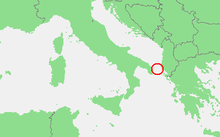Otranto lock
The Otranto barrier was a sea obstacle of the Entente in World War I , to block the KuK-Marine the way from the Adriatic into the Ionian Sea through the Strait of Otranto .
Starting position
After the London Treaty of April 1915, Italy switched sides and joined the Entente . As a result, the Adriatic became a frontline area alongside the Alps. Austria-Hungary thus found itself in a geopolitically unfavorable starting position at sea.
Place and type of implementation
The Otranto barrier was built in 1916 at the height of the Italian city of Otranto . It consisted of fixed network barriers , sea mines , listening stations on the Italian and Albanian coasts and permanent patrols by warships of the Entente powers and the Italian navy. The area was so well suited for a blockade because the passage from the Adriatic Sea into the Ionian Sea is only 75 kilometers wide and this was the easiest place to prevent the KuK Navy from penetrating the Mediterranean Sea.
consequences
Despite these measures, submarines of the KuK-Navy and those of the U-Flotilla Mediterranean of the German Imperial Navy repeatedly managed to break through into the Mediterranean and the Adriatic. Night and diving trips made it possible to drive through the barrier despite intensive surveillance of the enemy.
On May 15, 1917 there was a battle near Otranto , in which the Austro-Hungarian Navy inflicted great damage on the enemy and did not lose a single ship. The lock could be destroyed, but no benefit was taken from it. In the face of superior enemy ships, the Austro-Hungarian units had to withdraw, which gave the Allies the opportunity to re-form the barrier.
During a breakthrough attempt on June 10, 1918, the KuK battleship Szent István under liner captain Heinrich Seitz von Treffen off the island of Premuda was sunk by the Italian motor torpedo boat MAS 15 under the command of Luigi Rizzo by two torpedo hits.
Regardless of the actions of the KuK-Marine, the Otranto barrier remained intact until the end of the war.
See also
Individual evidence
- ↑ Martin Niemöller : From the submarine to the pulpit . Berlin: Martin Warneck Verlag, 1938.
